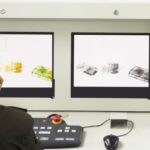 It’s commonly said that two minds are better than one, and a recent study from Brunel University suggests that is certainly the case when it comes to looking at images from places such as baggage scans.
It’s commonly said that two minds are better than one, and a recent study from Brunel University suggests that is certainly the case when it comes to looking at images from places such as baggage scans.
“There is a known problem with detecting rare targets,” the researchers say. “When you go to the airport, they always seem to find the bottle of water in your bag – it’s a very common item, so people have a mental template. They’ll just find it. But with rare targets like weapons and guns, people see these far less frequently, so are more likely to miss them.”
Unlocking the human visual system
Central to the challenge is the way the human visual system works. The researchers highlight how it is only really capable of processing a few objects in any kind of detail at once. This causes the brain to average our any redundant and specific information, with gaps filled in using prior knowledge. This is fine so long as objects are common, but if they aren’t it causes problems.
This problem can be overcome however if two people look at the same image independently of each other.
“We found that when we pair the estimates of two people who don’t know they’re working together – they have no interaction whatsoever – there is a huge improvement in detection, just by capitalizing on the diversity of people’s judgments,” the researchers say.
The research consisted of a couple of experiments, with participants required to perform tasks consistent with screening for baggage at an airport, and for mammograms in a hospital. None of the participants had any experience in their chosen task, and were shown the image for around half a second. They were asked whether they would like to call the image back depending on whether they spotted a target object.
“The experiment tested weapons detection as well as simple detection tasks,” the researchers explain. “We found that not only did pairing observers estimates improve detection in both types of tasks, but that pairing individuals’ estimates from the simple task in a way that maximized the decorrelated patterns actually improved the performance in the separate weapons task.”
Pairing up
The results revealed that people were much more accurate when there were two people working on the assessments independently of each other. The detection rate of rare objects increased, but there was also a significant reduction in the number of harmless items that were wrongly flagged.
Similar results were achieved when participants were asked to assess mammogram images to try and spot tumors in them. As before, the detection rate increased significantly when two people attempted it and their attempts were averaged.
“The task is not so different between airport scanner and a radiologist – the idea is you’re looking for something you have knowledge of but see infrequently,” the researchers explain. “It doesn’t matter though whether it’s a tumor or a weapon or something else, averaging two different perceptions of the same scene increases detection.”
The team believe this method of doubling up can present a significant improvement on the methods currently used in airports, despite appearing to double the number of personnel required. With the pool of highly trained experts who can detect rare targets relatively low, the team believe their approach helps to maximise the use of these people.
“Obviously the limit here is that it requires a second set of eyes, but we’re now looking for ways to use a deep-learning algorithm to cover the aspects of the images which are causing these decorrelations. We can then pair a single person with the algorithm,” they explain.